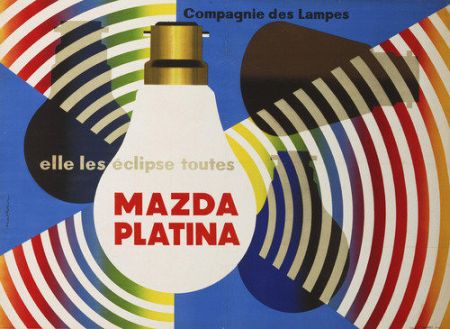ELECTRIC CURRENTS
MoMA The Museum of Modern Art
Projects Gallery, second floor
11 West 53 Street - New York
28/3/2012 - 30/9/2012
Electricity — a source of clean, efficient power and brilliant, reliable light—epitomized the very spirit of modernism in the early 20th century. After decades of research and competitive experimentation following the development of the first arc lamps and incandescent filament bulbs in the mid-19th century, electricity began to transform every aspect of modern life.
Electric light—first in city streets and then in homes—brought a revolutionary innovation to daily existence, literally redefining day and night. This installation features a dozen posters from MoMA’s collection used in this period to promote electricity, which offered staggering possibilities for progress but was not universally welcomed. In creating graphics for industry leaders like AEG and Bosch, modern designers were inspired by the beauty of the bulb itself and the splendor of electric light, which are both rendered with exquisite power in Jacques Nathan-Garamond’s poster of c. 1938, which pulsates in 2-D. The installation highlights a selection of Lester Beall’s equally vibrant posters for the Rural Electrification Administration, which used bold, patriotic graphics to foster public awareness of the benefits of electricity in America’s homes and farms during the Great Depression.
MoMA The Museum of Modern Art
Projects Gallery, second floor
11 West 53 Street - New York
28/3/2012 - 30/9/2012
Electricity — a source of clean, efficient power and brilliant, reliable light—epitomized the very spirit of modernism in the early 20th century. After decades of research and competitive experimentation following the development of the first arc lamps and incandescent filament bulbs in the mid-19th century, electricity began to transform every aspect of modern life.
Electric light—first in city streets and then in homes—brought a revolutionary innovation to daily existence, literally redefining day and night. This installation features a dozen posters from MoMA’s collection used in this period to promote electricity, which offered staggering possibilities for progress but was not universally welcomed. In creating graphics for industry leaders like AEG and Bosch, modern designers were inspired by the beauty of the bulb itself and the splendor of electric light, which are both rendered with exquisite power in Jacques Nathan-Garamond’s poster of c. 1938, which pulsates in 2-D. The installation highlights a selection of Lester Beall’s equally vibrant posters for the Rural Electrification Administration, which used bold, patriotic graphics to foster public awareness of the benefits of electricity in America’s homes and farms during the Great Depression.
